From the Resene decorating blog
As human beings, colour influences everything in our world from art and science, to what colour we paint our walls, to how we dress. Interior designers use colour to create certain atmospheres and psychologists may use it to influence moods.
Yet what do we know about the mechanics of colour? If we said colour was a function of light and biology you might think we were nuts. But in reality, light stimulating the retina of the eye is what creates our perception of colour.

Specifically, colour is light of different wavelengths. Our eyes detect certain wavelengths on the electromagnetic spectrum and these visible wavelengths are part of what we call the visible light spectrum. At one end of the visible light spectrum we have long wavelengths of light that we perceive as red. At the other end of the visible light spectrum we have short wavelengths of light, which we perceive as blue. All the other colours that we see every day are found along the visible spectrum between the reds and blues, in differing wavelengths.
When light hits an object, wavelengths are absorbed or reflected, depending on what the object is. Grass looks green because it has absorbed all the wavelengths except green, which is reflected back to our eyes. Our retinas detect those wavelengths and our brain then processes the information to create what we perceive as colour.
To make things a little tricky though, different kinds of light sources affect the way we perceive colour.
Have you ever noticed how a pair of items appears to match under one light source but under another light source they look different? This is known as metamerism. Metamerism is a phenomenon that occurs when colours change when viewed in different light sources.
Take the dark blue/black sock scenario. You take a pair of apparently black socks out of the drawer, then realise later that one of them is actually blue.

Walls in Resene Road Trip (try Resene Cement for another option), floor in Resene Colorwood Bark wood stain, fireplace in Resene Dark Side (try Resene Indian Ink for another option), ladder, basket and picture frame in Resene Truffle, side table and round tray in Resene Gumboot, coffee table in Resene Castaway on Resene FX Crackle Glaze, tall vase in Resene Castaway and logs in Resene Calibre, Resene Castaway, Resene Entourage and Resene Alpaca.

Walls in Resene Coriander, vanity in Resene Colorwood Black Pepper wood stain, floor in Resene Colorwood Walnut wood stain, stool in Resene Paddock, and slatted bathmat in Resene Seaweed, Resene Scaramanga, Resene Secrets and Resene Coriander.
The reason for the optical illusion is that wavelength emission between various light sources, such as incandescent and fluorescent light, differs. Incandescent lights transmit a lot of red wavelengths and very few blue wavelengths which makes it hard to tell whether a colour we see in such light is dark blue or black. Fluorescent light, on the other hand, emits more blue wavelengths, so it's easier to distinguish the two colours. Wavelengths not present cannot be reflected, which is why artificial lighting can change the way we see an object’s colour.
Paint colours, when viewed under different light sources, are also affected by metamerism, which is why your Resene ColorShop Professional will advise you to paint your Resene testpot of colour onto a piece of card and move it about the room you intend to paint so that you can see it under different lights, at different times of the day, both day and night. But it’s also true that surface characteristics, such texture and gloss levels, will affect colour.
“You could put white onto a texture such as a stucco wall and it won’t look the same as white put onto a lacquered kitchen door,” says designer and decorator Sylvia Sandford. “The higher the gloss level on a surface, and the smoother the surface it is, the more reflective it’s going to be, the more it’s going to change. A flat white colour on a stucco wall will appear heavy and won’t reflect anything. On a smooth surface, and if we use a high gloss, it’s going to reach out into the room and grab every colour that’s around. It’s going to be full of deception. It’s going to deceive you.”
Colours that have more depth to them will hold their own though
“Pure hues of red, blue, green or yellow, your basic primary and secondary colours, will actually hold their own because they’re not going to be influenced dramatically by what’s around them,” says Sylvia.


“The colour that has a high content of white is easily affected by what’s around it because light colours are more responsive to what is around them. They draw on textures, patterns and other colours, just through the sheer nature of being light.”
Thus the surrounding environment is a key component to consider when choosing paint colours.
“If a room is small and dark to start with,” says Sylvia, “whites will obviously change colour. It won’t be the same colour. It’s not getting the same light reflection or the same level of light onto it so it’s going to change. But you can manipulate colour by putting artificial light onto it. Artificial light gives you a lot of choices as to how a colour can look.”
Outdoor environments can also affect the colour dynamics inside a room.
“If you’ve got a concrete paved area outside and a swimming pool, light will bounce off that into your house,” says Sylvia. “It will get inside that room and it will start to have a party. It will just start dancing around the room. That’s why there is absolute horror from people who might have a dark blue sofa on a back wall in a sitting room and it’s faded. It’s not even in the sun. It’s faded because the light is dancing and it’s reflecting off different surfaces.”
When choosing colours for the house exterior, and to a certain extent the interior, the light reflectance value (LRV) of each colour is an important consideration, especially when choosing darker colours.
“Dark colours absorb more light and, depending on what they’re put on it, can actually create a problem for the material,” says Sylvia. “For instance, the weatherboards and in some cases the framing can warp through the heat that is built up on the plaster on the exterior. It pays to know and get advice from your council as to what the rating is for the particular material that you’re using.”
For this reason, you’ll notice the LRV is indicated on Resene’s colour charts. But Resene has also introduced Resene CoolColour™ technology, which makes painting exterior surfaces in dark colours both easier and safer. It can be used on all sorts of exterior materials and applications, from weatherboards and concrete to windowsills. A Resene CoolColour™ looks like a normal colour but thanks to special pigment technology it reflects more heat, so it doesn't get as a hot as a standard colour would.
But what if you want to research colour options online? Before you reach for your mouse, you need to understand the differences between physical colour charts and electronic colour charts and how the same colour may change slightly between the two.
There are two basic ways of reproducing colour. Mixing paint colours is called subtractive colour. This means that the colour you see is the colour that the paint does not absorb. For example yellow paint appears yellow because it absorbs (subtracts) all colours except yellow.
Mixing light colours is called additive colour. This means that the object gives out (emits) colour, so that even if it is dark you can still see the colour. Television and computer screens use additive colour because they emit colour. Even if the room is completely dark, if you turn the television or computer on you can still see the television programme or what’s on the computer. However, if you tried to read a book in a completely dark room you wouldn’t be able to see the words as the ink uses subtractive colour. The words in a book need light for them to be seen.
Both additive and subtractive colours use different colour systems. In effect, the two are opposites. So due to the different colour systems and the limitations of the additive RGB colour system, the RGB colour system portrays some paint colours better than others.
While electronic colour is a superb tool for visualising the paint scheme prior to painting, it shouldn’t be used as a substitute for the physical colours.
“Colour is a powerful tool,” says Sylvia, “but understanding it is complex.” It’s good to ask for help if you’re not confident of your choices – either ask your Resene ColorShop Professional, hire a Colour Consultant or try the free Resene Ask a Colour Expert on the Resene website.
The mechanics of colour is well worth getting your head around so you achieve a colour scheme that you love to be surrounded in.
November 29, 2013
Visit your local Resene ColorShop for expert advice and all the products and accessories you need to make the most of your home.
Book a colour consult | Ask a Colour Expert | Ask a Paint Expert
Resene's decorating blog
Paint your home beautiful! Discover the latest decorating trends, tips and colour news.
![]()
Previous «
Colour therapy
![]()
Blog home
View the latest trends, tips and news
![]()
» Next
Jazzing up furniture